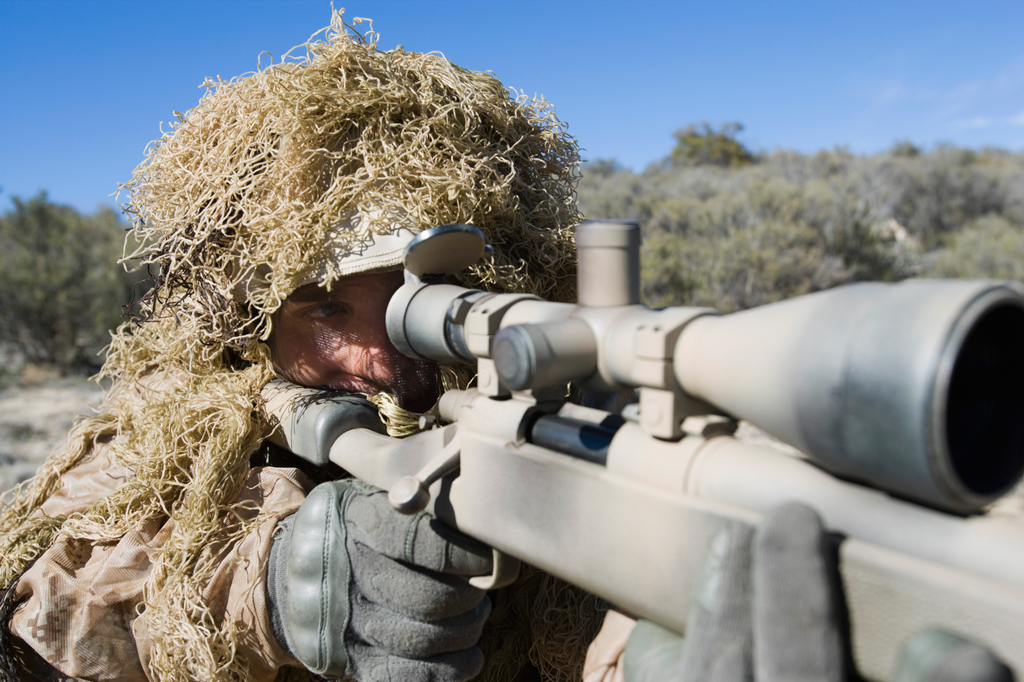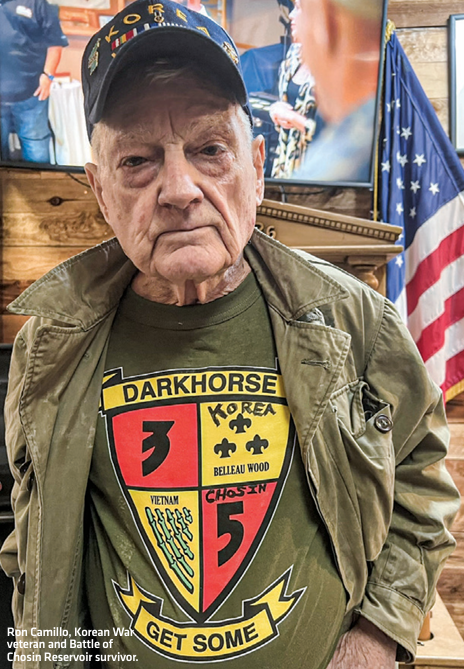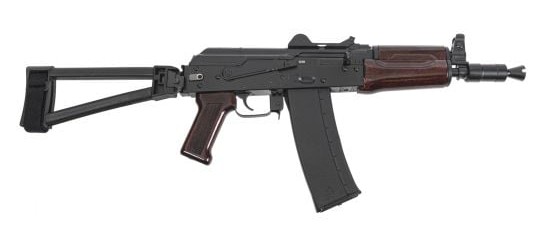The Long Road to Recognition – Updated
In 1944, the War Department Basic Field Manual FM 21-75, Infantry Scouting, Patrolling and Sniping defined the sniper as “…an expert rifleman, well qualified in scouting, whose duty is to pick off key enemy personnel who expose themselves. By eliminating enemy leaders and harassing the troops, sniping softens the enemy’s resistance and weakens his morale.” That definition remains consistent through the broader history of sniping, before and since, whether the weapon was a crossbow or a high-powered, telescopically sighted rifle.
The sniper is an incredibly efficient fighter, compared to the typical infantryman. Consider that in World War II, American infantry units fired 25,000 rounds to kill just one enemy soldier. By the Korean War, that figure jumped to 50,000 rounds, and the select-fire M14 and M16 infantry rifles of the Vietnam War only seem to have produced more misses, requiring the expenditure of 200,000 rounds to kill one enemy combatant. Nowadays, it’s a quarter million rounds of spraying and praying to kill a single Taliban. By comparison, on average, a sniper requires only 1.3 bullets to kill an enemy. During the Vietnam War, it was noted on many occasions that a handful of snipers accounted for more enemy killed than the entire infantry battalion (and sometimes even regiment) they were assigned to.
It was the wildly disproportionate contribution of snipers in the Vietnam War that set the stage for the first permanent peacetime sniper training programs. The U.S. Marine Corps set theirs up first at Quantico, Va., in 1977, and the U.S. Army followed suit at Fort Benning, Ga., in 1985. Snipers were finally on the TO&E (Tables of Organization & Equipment) of combat units, which meant they would always be ready for deployment. The rigorous training programs ensured the accumulated knowledge, gained from combat experience, would be preserved and ready when it was needed. Another critically important achievement of the USMC Scout Sniper and U.S. Army Sniper Schools was the creation of the U.S. military’s first purpose-built sniper rifles. Again, the USMC led the way with the M40A1 and the U.S.
Army followed with the M24 Sniper Weapons System. Both were based on the Remington 700-bolt action rifle, chambered in 7.62x51mm NATO. Prior to that, snipers used standard service rifles, specially selected for their accuracy and equipped with telescopic sights or commercial, offthe-shelf sporting rifles, as was the case in the black powder era and the Vietnam War. The upside of using the standard service rifle as the basis for a sniper conversion was complete parts and ordnance maintenance support from the normal supply channels. The downside was that the most accurate service rifles were not nearly as good as the best commercially available hunting rifles. The accuracy of the service rifle was always hampered by hand guards, stacking swivels and bayonet lugs hanging off the barrel – items totally useless to a sniper.
It is ironic that a country built on a tradition of rifle marksmanship took nearly 200 years to formally embrace the sniper, the man that represents the military apex of that long tradition. In each major war, through Vietnam, our armed forces began with no snipers and had to create training programs, usually in the theater of operations, to train them on the spot. Training varied from none to good, but the typical formula that has made many a successful American sniper is a rural background with early and continuous exposure to hunting or competitive, rifle shooting. Time after time, at the conclusion of the war, the sniper schools were closed and the snipers faded away.
The knowledge they gained in the deadly art of hunting men faded away with them and had to be retaught in the next war. This happened because America’s senior military leaders saw the sniper as a specialist, of small importance compared to the conventional infantry, artillery, cavalry (and later armored) forces who massively outnumbered him. From the general’s point of view, snipers didn’t win wars; huge armies did.
DURING THE AMERICAN REVOLUTION, volunteers from the frontier colonies took their long rifles to war. No British soldier within 400 yards was safe, and 200-yard, one-shot-kills were common. Riflemen terrorized the British, on the march and in garrison, picking off officers and noncommissioned officers from hidden positions. Without any formal guidance, they were doing exactly the same mission as snipers do today, but the British had far greater respect for them than General George Washington. Slow to load and lacking the capacity for a bayonet, the rifles and the unruly men who wielded them were ill-suited to the linear tactics of the day. General Washington thought the riflemen were more trouble than they were worth and didn’t want them in the Continental Army.
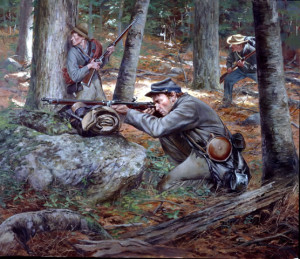 In the American Civil War, snipers were called sharpshooters and recruited for their marksmanship skill. The percussion-lock rifled musket and minie ball of the period greatly increased accuracy, without sacrificing speed of loading, and made the battlefield a much deadlier place. Some sharpshooters made use of early telescopic sights and many used their personal weapons in battle. The breech-loading Sharps rifle was popular among Union sharpshooters because it could be loaded lying down, behind cover. The standard muzzle loading, rifled musket required the soldier to stand up to load it, thus exposing himself to enemy fire.
In the American Civil War, snipers were called sharpshooters and recruited for their marksmanship skill. The percussion-lock rifled musket and minie ball of the period greatly increased accuracy, without sacrificing speed of loading, and made the battlefield a much deadlier place. Some sharpshooters made use of early telescopic sights and many used their personal weapons in battle. The breech-loading Sharps rifle was popular among Union sharpshooters because it could be loaded lying down, behind cover. The standard muzzle loading, rifled musket required the soldier to stand up to load it, thus exposing himself to enemy fire.
Confederates favored the British Whitworth rifle (maybe the first long-range sniper rifle in the world), when they could get it. With its unique hexagonal shaped, fast-twisting bore, instead of conventional cut rifling, it fired a six-sided bullet accurately just over a mile. It was the first military rifle built for long range accuracy. A Confederate sharpshooter, armed with a Whitworth rifle, killed Union General John Sedgwick at the Battle of Pennsylvania from a range of 800 yards.
The Whitworth rifle was capable of hitting the target at a range of 2,000 yards.
Designed by Sir Joseph Whitworth, a prominent British engineer, it used polygonal rifling instead, which meant that the projectile did not have to bite into grooves as was done with conventional rifling. DURING WORLD WAR I, THE skill sets and standard operating procedures of our present-day snipers were developed and codified in no-man’s land and the trenches. By that time, the bolt action rifle reached the pinnacle of its development as an infantry weapon. It had a five- to 10-round magazine and fired a much smaller caliber, high-velocity and aerodynamic bullet, propelled by smokeless powder, up to 3 miles.
DURING WORLD WAR I, THE skill sets and standard operating procedures of our present-day snipers were developed and codified in no-man’s land and the trenches. By that time, the bolt action rifle reached the pinnacle of its development as an infantry weapon. It had a five- to 10-round magazine and fired a much smaller caliber, high-velocity and aerodynamic bullet, propelled by smokeless powder, up to 3 miles.
Once he had a suitable modern weapon, the scout sniper emerged in a form identical to the present day. Now actually called a sniper, he can engage targets at 1,000 yards with more precision than luck. Whether shooting from behind or in front of friendly lines, he selects his hiding place carefully and uses camouflage to conceal himself and his spotter. He may wait for hours or days to get a shot at his target. When and if he does fire, it is rarely more than a few shots before he must move to avoid detection. (Smokeless powder makes it much more difficult for the enemy to locate his position.)
Sniper rifles are now commonly equipped with telescopic sights. Germany, thanks to their world renowned optics industry, initially dominated the battlefield by putting 20,000 scoped rifles (some of them civilian hunting rifles) in the hands of its best marksmen. The Allied nations had to play catch up. The United States Army fielded the ungainly 6x magnification prismatic Warner & Swasey scope, mounted on the .30-06 M1903 Springfield Rifle. It looked strange and it was clumsy, but it worked. It had over twice the magnification of most scopes of the day.
 By World War II, telescopic sights improved and rugged, domestically made ones with fair weather resistance, like the 2.5x-power Lyman Alaskan (military M81/M82), were mounted on the standard .30-06 M1 semiautomatic rifle. The old M1903 Springfield, with an improved 10x-power Unertl scope, served the USMC, and the simplified M1903A4, with a 2x-power M73B1 scope was a substitute standard for both services. In World War II, the United States was almost continuously on the offensive.
By World War II, telescopic sights improved and rugged, domestically made ones with fair weather resistance, like the 2.5x-power Lyman Alaskan (military M81/M82), were mounted on the standard .30-06 M1 semiautomatic rifle. The old M1903 Springfield, with an improved 10x-power Unertl scope, served the USMC, and the simplified M1903A4, with a 2x-power M73B1 scope was a substitute standard for both services. In World War II, the United States was almost continuously on the offensive.
Both the Japanese and Germans often used snipers, suicidally, to cover their withdrawals and stall the allied advance. The greatest threat to a sniper is another sniper, so U.S. Army infantry platoons commonly designated a scout sniper in the headquarters section to be employed at the commander’s discretion. Contrary to our image of the American sniper as a lone wolf on the battlefield, they also fought as platoons. When the Marines invaded Betio in the Tarawa Atoll on Nov. 20, 1943, Lt. William D. Hawkins led his platoon of scout snipers on a mission, far in advance of the main forces. They hunted down, and eliminated, enemy machine gunners and snipers to protect the advance of their fellow Marines at the long pier. They fought with grenades and flamethrowers, as well as precision rifle fire. Lt. Hawkins died in the battle, but his ferocity in combat earned him the Medal of Honor.
Another fact that historian forget is that the U.S. Army’s lack of familiarity with sniping tactics proved disastrous in Normandy and the campaign in Western Europe where they encountered well trained German snipers.
In Normandy, German snipers remained hidden in the dense vegetation and were able to encircle American units, firing at them from all sides.
The American and British forces were surprised by how near the German snipers could approach in safety and attack them, as well as by their ability to hit targets at up to 1,000m. A notable mistake made by inexperienced American soldiers was to lie down and wait when targeted by German snipers, allowing the snipers to pick them off one after another. German snipers often infiltrated Allied lines and sometimes when the front-lines moved, they continued to fight from their sniping positions, refusing to surrender until their rations and munitions were exhausted.
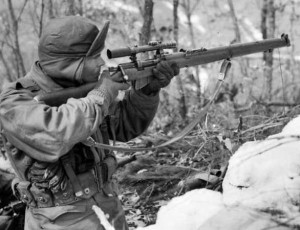 THE SNIPER’S ROLE IN THE KOREAN War bore similarities to World War I: static lines, an attrition strategy and costly frontal attacks. Once again, the precision contributions of the hastily The longest confirmed kill by an American sniper was taken with a semiautomatic .50-caliber BMG M82 Barrett. trained snipers (now equipped with M1D sniper rifles and 2.2x-power M84 scopes) was overshadowed by the mass slaughter wrought by concentrated small arms and artillery fire.
THE SNIPER’S ROLE IN THE KOREAN War bore similarities to World War I: static lines, an attrition strategy and costly frontal attacks. Once again, the precision contributions of the hastily The longest confirmed kill by an American sniper was taken with a semiautomatic .50-caliber BMG M82 Barrett. trained snipers (now equipped with M1D sniper rifles and 2.2x-power M84 scopes) was overshadowed by the mass slaughter wrought by concentrated small arms and artillery fire.
Korea was a big war fought in a small place. If machine guns had trouble stopping human-wave attacks used by the Communist Chinese, what could snipers possibly do? By contrast, snipers made undeniably significant contributions in the Vietnam War and all the wars that followed it. The nature and scale of combat changed in a manner that favored the sniper. Vietnam was a big war, but only in the aggregate. It was fought in small engagements over a large area and a long period of time.
In this environment, the sniper was on more equal terms with the enemy. Combat actions in Grenada, Beirut, Iraq and Afghanistan were likewise small in scale, compared to the World Wars and Korea. The superior equipment, training and communication of today’s snipers makes them the deadliest warriors on the battlefield.
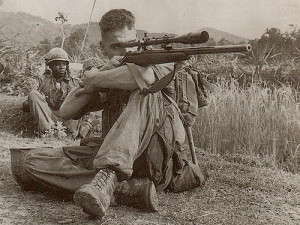 In Vietnam in 1967, USMC scout sniper legend Carlos Hathcock mounted a scope on an M2 .50-caliber heavy machine gun and used it to make the longest recorded sniper kill in history. His 2,286-meter record stood until 2002, when a Canadian sniper broke it by 24 meters in Afghanistan using a MacMillan Tac-50 bolt-action rifle in the same caliber. Hathcock’s improvised, ultralong-range, sniping demonstration was a harbinger of things to come. In 1990 the U.S. Army purchased the .50-caliber BMG M82 Barrett, semiautomatic sniper rifle for use in Operation Desert Shield/Desert Storm in Iraq. Later it would be standardized as the M107.
In Vietnam in 1967, USMC scout sniper legend Carlos Hathcock mounted a scope on an M2 .50-caliber heavy machine gun and used it to make the longest recorded sniper kill in history. His 2,286-meter record stood until 2002, when a Canadian sniper broke it by 24 meters in Afghanistan using a MacMillan Tac-50 bolt-action rifle in the same caliber. Hathcock’s improvised, ultralong-range, sniping demonstration was a harbinger of things to come. In 1990 the U.S. Army purchased the .50-caliber BMG M82 Barrett, semiautomatic sniper rifle for use in Operation Desert Shield/Desert Storm in Iraq. Later it would be standardized as the M107.
This rifle was used by Army Ranger Sgt. Bryan Kremer in Iraq, in March 2004, to make the 2,300-meter kill that now stands as the farthest for an American sniper. His was the fourth-longest kill shot in recorded history. For the record, the credit for the farthest kill goes to British sniper Craig Harrison, who made an incredible 2,475-meter shot with an Accuracy International L115A3 rifle in .338 Lapua Magnum.
Fast forward to 2017, a Canadian sniper who is part of an elite Joint Coalition Force battling against ISIS in Iraq. Takes a successful shot from 3,540 meters away at a militant, which took almost 10 seconds for the bullet to reach its target.
 The .338 Lapua round was designed to out range the powerful .300 Winchester and extend the sniper’s lethality to 1,600 meters. Chief petty officer Chris Kyle used a McMillan Tac-338 bolt-action rifle in .338 Lapua Magnum to make his farthest kill, at 1,920 meters, against an enemy combatant about to fire an RPG at a passing American convoy. In World Wars I and II, American snipers were expected to make 600-yard hits. This was reasonable, in light of the limitations of their service-riflebased sniper rifles, and the ordinary ball ammunition they had to use. Today’s sniper is expected to hit the target at twice that range.
The .338 Lapua round was designed to out range the powerful .300 Winchester and extend the sniper’s lethality to 1,600 meters. Chief petty officer Chris Kyle used a McMillan Tac-338 bolt-action rifle in .338 Lapua Magnum to make his farthest kill, at 1,920 meters, against an enemy combatant about to fire an RPG at a passing American convoy. In World Wars I and II, American snipers were expected to make 600-yard hits. This was reasonable, in light of the limitations of their service-riflebased sniper rifles, and the ordinary ball ammunition they had to use. Today’s sniper is expected to hit the target at twice that range.
The sniper’s skills remain the same, but his tools have greatly improved. Laser range finders, bipods, high-magnification scopes, night-vision scopes, match grade ammunition, rugged specialty rifles built to take the abuse of combat and deliver competition accuracy, and excellent, often continuous communication, all contribute to getting the bullet where the sniper needs it to go, with greater accuracy than ever before possible.
The film American Sniper has grossed over $250 million as of this writing, making it the most popular war film in American history. Its themes resonate with the public right now and are sure to generate an increased interest in long-range rifle marksmanship that will serve the cause of freedom well in wars to come. The film tells a slightly fictionalized account of the life of the aforementioned SEAL sniper Chris Kyle, who learned to shoot as a boy in rural Texas, perhaps not unlike our sharpshooters of yore, and became one of the most successful snipers in U.S. military history, saving countless American lives on the battlefield with his shooting ability.
Here are some questions about Snipers:
Who is the Deadliest Sniper in history?
 During the Winter War in 1939-1940, one of the deadliest sniper to be given credit is Simo Häyhä. He had more than 505 kills, more than 13,550,000 bullets would have been needed in Vietnam.
During the Winter War in 1939-1940, one of the deadliest sniper to be given credit is Simo Häyhä. He had more than 505 kills, more than 13,550,000 bullets would have been needed in Vietnam.
Häyhä fought for Finland against the Soviet Union. During his 98-day reign of terror, Häyhä was unseen and unheard, yet was all the while targeting Russian soldiers with deadly accuracy, once even killing 25 men in one day.
With snipers presenting such a high-value targets on the battlefield, Simo’s reputation as a marksman soon reached the Russian front lines; they referred to him as “The White Death”. He remains the deadliest sniper who ever lived.
Do Snipers go for head shots?
Military snipers, who generally do not shoot at targets at less than 300 m (330 yd), usually attempt body shots, aiming at the chest.
What magnification scope do snipers use?
The standard 10x scope are used. This has been considered the ideal magnification for those needing to make body shots on targets at medium to long range. It is best used from 250 yards on out to 1000.
What range do snipers zero?
Zeroing is very precise, if you have a small error at 100 yards this becomes bigger one at 1,000 yards. If your zero is off by just ½-inch at the 100-yard mark, this could mean five full inches further down range.
What is the best scope magnification for 1000 yards?
- Schmidt and Bender PM II High Power 5-45×56 (34mm Tube)
- Nightforce 5.5-22×50 NXS Riflescope
- Primary Arms Platinum Series 6-30x56mm Riflescope
- Vortex Razor HD 5-20x Riflescope
- Leupold MK 4 LR/T 4.5-14x50mm M1 TMR
What is the most powerful sniper scope?
Nightforce Optics 5.5-22×56 NXS Riflescope – its considered one of the most advanced field sniper scopes in the market today. Its wide magnification allows for precision accuracy at the longest range.
what’s a decent scope for 1000 yards?
- Steiner T5Xi 5-25x 56mm Riflescope
- Vortex Viper HST 6-24×50 Riflescope
- NightForce 5.5-22×56 NXS Riflescope
Why do Snipers need spotters?
A spotter calculates the distance, and makes the wind call. The sniper on the gun follows directions, so both people know where they stand if the first shot misses. Which both can assess to make changes.
How far can Snipers shoot?
World’s longest sniper kill – 2.47km twice! With great skill sets and technology with a little luck from mother nature, the distance will continue to increase. Making a sniper most feared person on the battle field along with being one of the most cost effective way of killing an enemy.
Do Snipers sleep?
Snipers usually work in teams, one sniper often rests while the other remains awake and alert. .. Snipers don’t remain out in the field for too lengthy periods of time as that degrades their edge and competency.
What makes a sniper a sniper?
The sniper, a soldier trained in precision, long-range fire, is one of the most feared opponents on the battlefield. Snipers can make their presence felt far beyond a typical soldier’s assault rifle, cutting down enemy leaders, radio and heavy weapons operators, and damaging enemy equipment at considerable distances.


